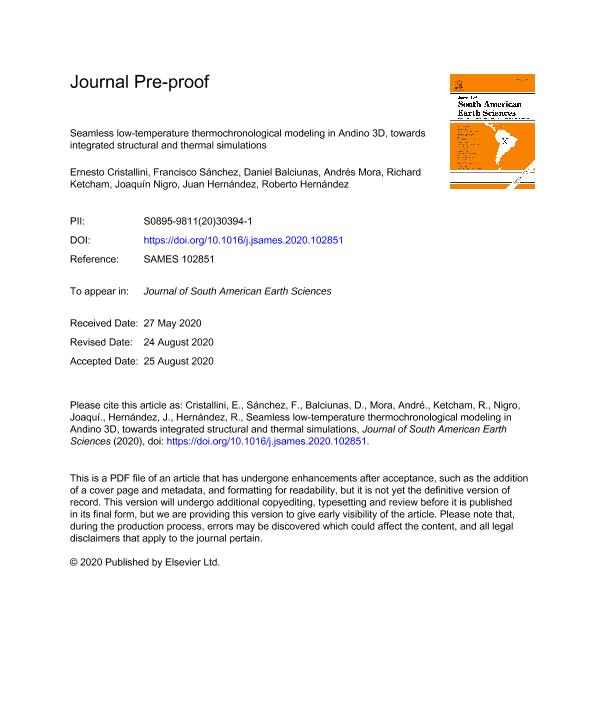Mostrar el registro sencillo del ítem
dc.contributor.author
Cristallini, Ernesto Osvaldo

dc.contributor.author
Sánchez Nassif, Francisco Gabriel Antonio

dc.contributor.author
Balciunas, Daniel Eduardo

dc.contributor.author
Mora, Andrés
dc.contributor.author
Ketcham, Richard
dc.contributor.author
Nigro, Joaquín

dc.contributor.author
Hernández, Juan
dc.contributor.author
Hernández, Roberto
dc.date.available
2021-11-11T01:01:35Z
dc.date.issued
2021-01
dc.identifier.citation
Cristallini, Ernesto Osvaldo; Sánchez Nassif, Francisco Gabriel Antonio; Balciunas, Daniel Eduardo; Mora, Andrés; Ketcham, Richard; et al.; Seamless low-temperature thermochronological modeling in Andino 3D, towards integrated structural and thermal simulations; Pergamon-Elsevier Science Ltd; Journal of South American Earth Sciences; 105; 1-2021; 1-16
dc.identifier.issn
0895-9811
dc.identifier.uri
http://hdl.handle.net/11336/146633
dc.description.abstract
We present the development of thermochronological tools for Andino 3D® software, that integrates Fetkin (Finite Element Temperature Kinematics). These tools allow the user to work on both the structural and the thermochronological model at the same time, providing a user-friendly environment that overcomes the need to work with different programs. Thermochronological and structural models can be checked and eventually corrected in a visual and intuitive form by following a 4-step workflow. The first step of such workflow is to define the thermochronological computing grid, checking in real time, if the resolution and coverage are satisfactory. After that, the interpolation process can be done, whereby velocity vectors for all nodes in beds and faults are calculated for all interpolated times. The third step of the workflow consists of filling thermal properties and velocities for all grid cells. The final step is the calculation of the thermal state at each time in the reconstruction. Boundary conditions (basal temperature, basal heat flow, surface temperature and altitude gradient) are defined by mouse picking as constant, spatially varying, time varying or spatially and time varying. To check the feasibility of a structural model, thermochronological samples can be defined at desired positions to predict time-temperature variations. Simulated fission track ages, mean track lengths and age standard deviations can be calculated for different minerals (apatite and zircons). Also, cooling ages and %Ro can be simulated for (U–Th-Sm)/He and vitrinite systems, respectively. The Carohuaicho structure in the southern Bolivia sub-Andean Ranges is presented as a case of study to demonstrate these tools. Andino 3D® allowed us to successfully simulate the t-T paths of four samples where (U–Th-Sm)/He measurements were available. The different models performed permitted us to conclude that a low geothermal gradient was likely to be present during the last 7 Ma of Andean deformation in the study region.
dc.format
application/pdf
dc.language.iso
eng
dc.publisher
Pergamon-Elsevier Science Ltd

dc.rights
info:eu-repo/semantics/openAccess
dc.rights.uri
https://creativecommons.org/licenses/by-nc-nd/2.5/ar/
dc.subject
APATITEFISSION TRACK
dc.subject
BOLIVIA
dc.subject
CAROHUAICHO
dc.subject
KINEMATIC EVOLUTION
dc.subject
STRUCTURAL EVOLUTION
dc.subject
SUBANDINE RANGES
dc.subject
THERMOCHRONOLOGY
dc.subject
TIME-TEMPERATURE
dc.subject
U-TH/HE
dc.subject
ZIRCON FISSION TRACK
dc.subject.classification
Geología

dc.subject.classification
Ciencias de la Tierra y relacionadas con el Medio Ambiente

dc.subject.classification
CIENCIAS NATURALES Y EXACTAS

dc.title
Seamless low-temperature thermochronological modeling in Andino 3D, towards integrated structural and thermal simulations
dc.type
info:eu-repo/semantics/article
dc.type
info:ar-repo/semantics/artículo
dc.type
info:eu-repo/semantics/publishedVersion
dc.date.updated
2021-09-06T15:11:26Z
dc.journal.volume
105
dc.journal.pagination
1-16
dc.journal.pais
Estados Unidos

dc.description.fil
Fil: Cristallini, Ernesto Osvaldo. La.te. Andes S.A. Thermochronology Lab; Argentina. Consejo Nacional de Investigaciones Científicas y Técnicas. Oficina de Coordinación Administrativa Ciudad Universitaria. Instituto de Estudios Andinos "Don Pablo Groeber". Universidad de Buenos Aires. Facultad de Ciencias Exactas y Naturales. Instituto de Estudios Andinos "Don Pablo Groeber"; Argentina
dc.description.fil
Fil: Sánchez Nassif, Francisco Gabriel Antonio. Consejo Nacional de Investigaciones Científicas y Técnicas. Centro Científico Tecnológico Conicet - Córdoba. Centro de Investigaciones en Ciencias de la Tierra. Universidad Nacional de Córdoba. Facultad de Ciencias Exactas Físicas y Naturales. Centro de Investigaciones en Ciencias de la Tierra; Argentina
dc.description.fil
Fil: Balciunas, Daniel Eduardo. La.te. Andes S.A. Thermochronology Lab; Argentina
dc.description.fil
Fil: Mora, Andrés. Ecopetrol Óleo e Gás do Brasil; Brasil
dc.description.fil
Fil: Ketcham, Richard. University of Texas at Austin; Estados Unidos
dc.description.fil
Fil: Nigro, Joaquín. La.te. Andes S.A. Thermochronology Lab; Argentina
dc.description.fil
Fil: Hernández, Juan. La.te. Andes S.A. Thermochronology Lab; Argentina
dc.description.fil
Fil: Hernández, Roberto. La.te. Andes S.A. Thermochronology Lab; Argentina
dc.journal.title
Journal of South American Earth Sciences

dc.relation.alternativeid
info:eu-repo/semantics/altIdentifier/url/https://www.sciencedirect.com/science/article/abs/pii/S0895981120303941
dc.relation.alternativeid
info:eu-repo/semantics/altIdentifier/doi/https://doi.org/10.1016/j.jsames.2020.102851
Archivos asociados
